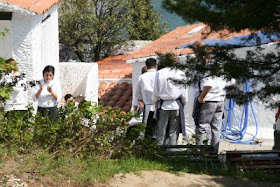 El Bulli dining room.
El Bulli dining room.
All photos by Pille & K of Nami-NamiThe surprising thing about El Bulli is that despite of their fame and the number of dishes served each night, they still take great interest in each diner's special wishes. While there is no traditional menu to choose from as such, they do want you to be able to enjoy all 30 dishes. When confirming our booking, they wanted to know about any food allergies or dietary considerations (yes, you can order a vegetarian or even a vegan meal). When we were seated, the waiter told us that the Chef has designed a 30-course meal for us, and that each dish will be explained as it is served. He then informed us that some items might be a bit unusual and off-putting - in our case razor clams and veal marrow - and could be changed for something more preferable. (I must confess I wasn't too keen on the razor clams, so I got an alternative dish. Funny enough, they forgot to mention that sea cucumber was on the menu as well. More about it later:)).
Ready? The menu could be split into five parts -
savoury snacks, tapas, main tastes, (pre-dessert), desserts and morphings. However, I've opted to split the menu into three posts, explaining the various phases as we go.
Tangerine / Mandarina 
The first dish we were served consisted of two parts. On a small black folded square paper were two tiny rose-scented granules. We were instructed to pop the rose granule into our mouth, and then drink the slightly foamy tangerine drink. As a result, the whole tangerine drink tastes strongly of rose :)
Spherical Olives / Aceitunas verdes sfericas 
I was so excited to see this dish! The spherical olives is probably one of the best known dishes on El Bulli's menu, and it was cool to have a chance to try them ourselves. It's an encapsulated pure olive pureé, marinated in olive oil, garlic, thyme and rosemary. We got two olives each, served with a special tiny spoon. You put the 'olive' into your mouth and when gently pressing it with your tongue, it bursts, leaving you with the taste of the best olive you've ever had. Very intense, very tasty.
El Bulli/Ferran Adria is famous for playing with textures, tastes and temperatures. The spherical olive is a great texture-teaser - you expect it to 'feel' like an olive, and although it tastes like one, it feels totally different.
Note that many of the dishes were to be consumed with our hands - utensils were rarely seen. Knife, for instance, was only brought to the table once (and I didn't really know how to use it then anyway :))LYO Fruits / Frutas LYO (Pineapple chips)
Pineapple chips came on a typical plate that looked a bit like crunched sheet of metal. LYO is short for lyophilization aka
freeze-drying. The freeze-dried pineapple chips look like your regular chips, but taste like pineapple and have a very fragile and slightly flaky texture.
Salty 'catanias' / Catanias saladas
Toasted walnuts covered in walnut praline and dusted with bitter cocoa powder. These managed to taste sweet and salty at the same time, and were apparently a play on a much-loved Catalonian chocolate-almond
bon-bon.
Nori-trias
Lightly salted and creamy black sesame paste filling, wrapped into a fragile-crispy nori sheet.
Tomato cookie / Galleta de tomate
Intensely tomato-flavoured crispy cookie, garnished with a gold leaf and wasabi dot. Very interesting texture.
Beetroot coral / Coral de remolacha

Slightly similar to the tomato cookie texture-wise (a bit crunchier, perhaps), but intensely beet-flavoured. First the crispy beetroot 'coral', then a spoonful of beet juice :)
The above small dishes fell into the savoury snacks category, and were served several at the time. The following few dishes are the tapas-dishes, served one at the time.Shiso flexia caramel with its own soft candy / Shiso caramelo flexia sus gominolas

This was one of the trickiest dishes to eat. The soft candies were VERY soft, and almost burst between our fingers (our only 'utensils' at this point). The 'flexia caramel' contained flecks of shiso (leaf? flower?) that were prone to fall all over the place when not eaten carefully. But flavour-wise, it was a lovely combination of mildly sour and sweet.
Pistachio sponge cake with acid milk mousse / Bizcocho de pistachios con mousse de leche acida
At first we thought this is the same pistachio mousse dish that Ferran Adria shares in the Foams and Espumas chapter of
The Cook's Book (a brilliant book, by the way!) - we had tried that at home. However, it wasn't - the visual similarity was all that was common. This pistachio cake was dry and fragile - as a result of lyophilization - and not moist and sponge-like. The pistachio cake was served with acid milk mousse (photo below) and we were given a tiny spatula for scooping up the mousse.

That red tome? Oh, that's their modest wine list :)
Black sesame sponge cake with miso / Bizcocho de sesamo negro y miso
This was one of my favourite dishes - with a cool texture and lots of flavour. Toasted black sesame seeds have been ground into a paste, mixed with egg and flour, pressed through an ISI Gourmet Whip and then microwaved until cooked and fluffy. (We had tried a similar recipe with pistachios, printed in
The Cook's Book: Step-by-step techniques & recipes for success every time from the world's top chefs). We were instructed to devour the sponge in two mouthfuls, starting with the miso paste part. Again, a great combination of textures (remember, we were holding the 'sponge' with our fingers) and flavours.












































